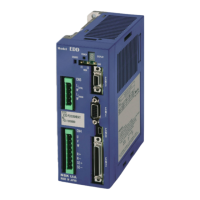6. Operation
— 6-30 —
6.3.4.2. Jogging via RS-232C Communication
The following shows procedures of a typical jogging operation via RS-232C communication.
When a jogging operation is run via RS-232C communication, regular carriage return after the jogging is
started, is strongly recommended, considering a communication failure due to an accident, such as
disconnection of cables.
Fig 6-22: Signal timing of jogging via RS-232C communication
*1: It takes 3.2 seconds to activate the Motor servo for the
very first time after turning on the main power.
*2: CR: Carriage return code 0D
H
1) Turn on the Motor servo by the input SVON (Servo on).
2) The output SVST (Servo state) is closed when the Motor servo is on.
3) Input the command JG/PL (Jog direction, plus direction).
The Motor starts jogging operation, following the parameter values of JA (Jog acceleration), JB
(Jog deceleration) and JV (Jog velocity).
Input the command JG/MI for a jogging in the minus direction.
Input a carriage return (0Dh) following the command JG within 0.5 seconds. When input of the
carriage return stops, the Motor decelerates and stops.
4) The output BUSY (In-operation) is closed during the jogging operation, and the output IPOS
(In-position) is open.
5) When the duration of carriage return exceeds 0.5 seconds, the Motor starts to decelerate.
6) The output BUSY opens at the completion of inputting the internal command for deceleration.
The output IPOS remains open at this time, since the jogging is started from the position at
where the prior positioning is completed.

